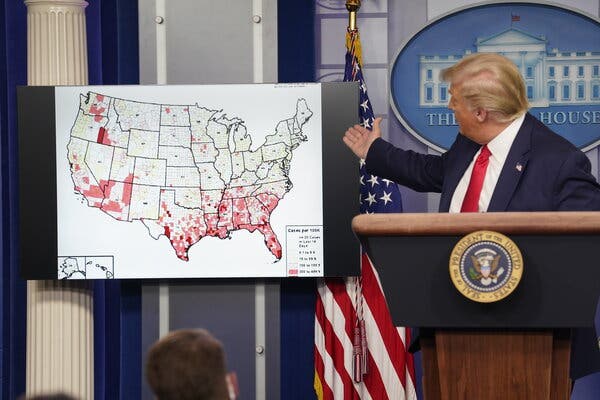
Digital composite image of mask representing the US political parties being joined together by a … [+] zipper – concept is uniting or mending bipartisan politics.
Getty
Masks are now mandatory in 21 states and will be coming to your state soon.
Most everyone agrees that our economy and job market will not return to normal until we defeat this coronavirus. There is, however, strong disagreement on exactly how to do this. Much of the disagreement centers on the issue of wearing masks in public. The coronavirus has created another rift, namely, the discord between republicans and democrats over how it should be handled. Nonetheless, until we have an effective vaccine, the threat from and disagreement over Covid-19 will remain. Having had the ‘mask debate’ with a few good friends, I thought it would be interesting to look at data from each state to see if any trends exist. For example,
· How is Covid-19 trending in states that have introduced a mandatory mask policy versus those who have not?
· How does the trend in new cases differ in states with a republican governor versus a democrat?
· How is the virus trending based on the political party in control of a state’s house and senate?
Here’s what I discovered, and it was quite surprising.
Covid-19 Trend in States With and Without a Mandatory Mask Policy
Thus far, early data seems to indicate that wearing masks is useful in reducing the spread of Covid-19. As of July 3, there are 21 states with some form of mandatory mask policy. In 14 of the 21, the policy was implemented over 30 days ago so there is ample time to evaluate the results. How are these 14 states doing? The average rise in new Covid-19 cases over the past 14 days in states with a mandatory mask policy is +16%. What about states without a mask wearing mandate? The average rise in new coronavirus cases in these 29 states is +79%.
NOTE: All data for this article can be found in the following exhibit.

Covid 19 Data by State Mask Mandate and Political Party in Office
MJP
Covid-19 Trend in States by Political Party (Overview)
The trend in new Covid-19 cases also varies by political party. For example, there are 15 states where democrats control the governorship and the legislature. In these 15 states, new coronavirus cases have risen by an average of +42% over the previous 2 weeks. In the 21 states where republicans control both the governorship and legislature, the average rise in new coronavirus cases over the past 2 weeks was +86%. In the 14 remaining states where neither party dominates, new cases have risen +56% during the same period.
Covid-19 Trend by State Governor
There are 26 states led by a republican governor and 24 with a democrat in charge. How are new coronavirus cases trending in these states? In states where a republican is in charge, the two-week trend in new cases, on average, is +70% compared to +59% in a democrat-led state.
Covid-19 Trend by State Legislature
Democrats control state legislatures in 20 states and the senate in 19. In states with a democrat majority in the house, the virus has trended higher in the past two weeks by +37% on average and +34% where democrats control the state senate. How do states with a republican majority in a state’s legislature compare? There are 29 states with a republican-controlled house and 29 states where republicans control the senate. The average increase in these states over the past two weeks is +86%.
Covid-19 Trend in All States
When you consider all 50 states, the average rise in new coronavirus cases during the past 14 days is +65%. The states with the most significant increase are Idaho (+291%); Montana (+201%); Florida (+193%); Mississippi (+174%); Nevada (+170%); Georgia (+167%); Louisiana (+131%); Texas (+125%); Alaska (+107%); and New Mexico (105%). The rest of the states are at, or below 100%. In 22 states, the coronavirus is rising at a rate faster than the national average, which is 65%.
Why are republican states doing worse in controlling the virus? Here are a few possible reasons. According to a recent Pew Research survey, 61% of republicans believe the worst is behind us while 76% of democrats believe the worst is yet to come. A majority of Republicans (63%) also believe the outbreak has been exaggerated while only 18% of democrats share this view. Thus, republicans seem to feel less threatened by the virus than democrats.
Although the numbers are interesting, short of a vaccine, the coronavirus conundrum and resulting economic woes will persist until we have a coordinated policy to reduce its spread. The problem is that Americans can’t seem to agree on just how bad Covid-19 is and what should be done to combat it. There is also a great deal of disinformation on the subject, leading to significant confusion. The sooner we work together to put this outbreak behind us, the sooner we will be able to return to normal life and economic prosperity. It’s up to us.

